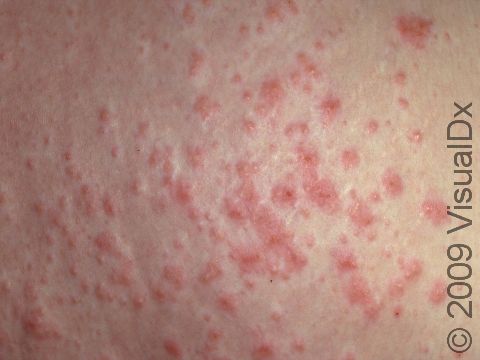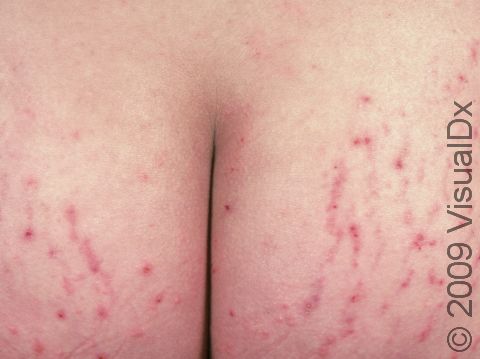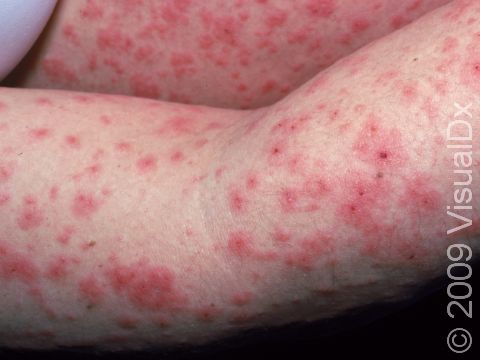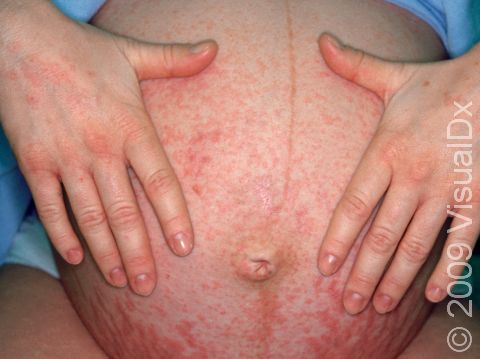PUPPP (Pruritic Urticarial Papules Plaques of Pregnancy)
Pruritic urticarial papules and plaques of pregnancy (PUPPP) is the most common skin condition of pregnancy. Typically, women affected by PUPPP develop red, itchy bumps on the belly near stretch marks (striae) during their third trimester. PUPPP usually gets better within a few weeks after delivery, does not affect the health of your baby, and has no long-term consequences for you.
Who's At Risk?
PUPPP is common in pregnant women, occurring in approximately 1 in every 200 pregnant women. The cause is unknown but has been thought to be due to increasing hormones, skin stretching (distention), and various reactions of the immune system. PUPPP usually appears in the third trimester, most often during a woman’s first pregnancy and in women expecting multiple babies. PUPPP typically does not occur in woman in second or later pregnancies.
Signs & Symptoms
The earliest signs of PUPPP are red, itchy bumps near areas of stretch marks. These bumps may spread to other parts of the body, usually to the chest, arms, and legs. It is uncommon for the rash to appear on the face, palms, or soles of the feet. The individual bumps may get larger and form raised, red areas that look like hives. Blisters filled with liquid may also be seen. Although the appearance of the rash can vary and change over time, most women’s main concern is the intense itching that is a key component of this condition. PUPPP usually goes away about 1 week after delivery (postpartum) but can disappear anywhere from a week before delivery to up to 6 weeks postpartum.
Self-Care Guidelines
Thick moisturizers can be applied to the rash throughout the day to prevent dryness and relieve itching. An over-the-counter topical steroid such as hydrocortisone (0.5 or 1%) may be applied to affect areas. An over-the-counter antihistamine such as diphenhydramine (Benadryl®) is safe to take during pregnancy and can decrease the itching, but it may make you sleepy. Loratadine (Claritin®) and cetirizine (Zyrtec®) are other antihistamines that are less sedating and may help during the day.
Treatments
Your doctor may give you a prescription for a topical corticosteroid. In rare cases, you may need oral corticosteroids.
Visit Urgency
The most common treatment your doctor will give you is a steroid cream – either prescription-strength or something available over the counter – to be applied directly to the affected areas. Only in severe cases are oral steroids required to control the itching. Rarely, if your doctor is unsure of the diagnosis of PUPPP, he or she may recommend a skin biopsy to confirm the diagnosis.
Trusted Links
References
Broza Z, Kasperska-Zajac A, Oles E, Rogala B. Pruritic urticarial papules and plaques of pregnancy. J Midwifery Womens Health. 2007;52(1):44-48. PMID: 17207750.
Thurston A, Grau RH. An update on the dermatoses of pregnancy. J Okla State Med Assoc. 2008;101(1):7-11. PMID: 18390233.
Tunzi M, Gray GR. Common skin conditions during pregnancy. Am Fam Physician. 2007;75(2):211-218. PMID: 17263216.
Last modified on October 10th, 2022 at 4:42 pm

Not sure what to look for?
Try our new Rash and Skin Condition Finder



